
* After developing the disappointing XF-90 long-range fighter, in response to feedback from the air war in Korea Lockheed decided to come up with a breathtakingly new design, resulting in the F-104. It would be obtained by the US Air Force in relatively small numbers and see limited combat with the Air Force in the Vietnam War.
* The Lockheed Aircraft Company had been a pioneer in US military jet aviation by developing the first fully operational American jet fighter, the "P-80 / F-80 Shooting Star". While the F-80 was quickly overtaken by improvements in fighter design, it was the basis for the classic "T-33" trainer, and would also evolve into the "F-94 Starfire" series of all-weather interceptors.
Aircraft design was moving very rapidly in the years after World War II, and Lockheed needed to keep up the changes by developing improved jet fighter aircraft. Unfortunately, the company had trouble moving forward. In 1946, in response to a US Army Air Forces (USAAF) requirement for a long-range "penetration" fighter that could fly deep into enemy (read "Soviet") airspace and also perform ground-attack missions, a Lockheed design team under Don Palmer and Bill Raston submitted a proposal. The USAAF awarded Lockheed a contract for two prototypes, to be designated "XP-90", later "XF-90". The USAAF also awarded parallel contracts for the McDonnell "XF-88 Voodoo" and the North American "YF-93A", which was a highly modified derivative of the North American F-86 Sabre fighter.
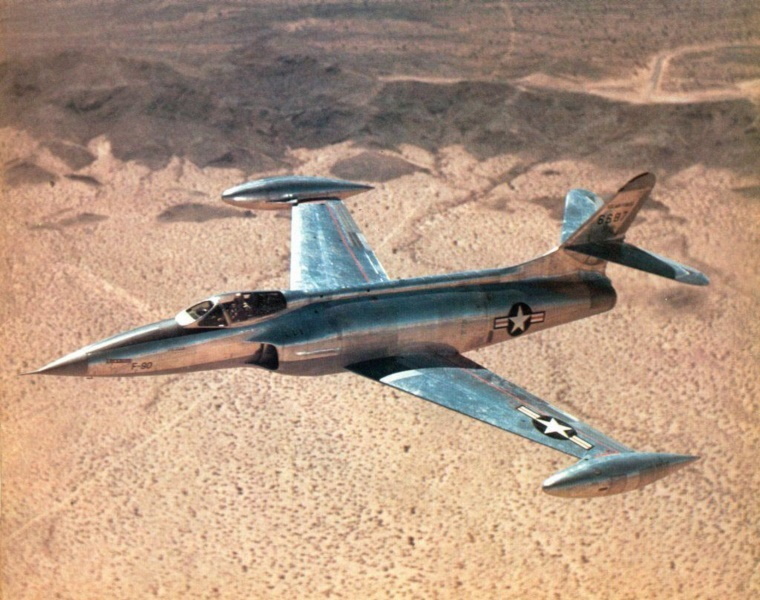
The two XF-90 prototypes were built, the first performing its initial flight on 3 June 1949 with Lockheed test pilot Tony Levier at the controls. Although the Lockheed design team considered a wide range of possible configurations for the XF-90, including a delta-wing design, as it emerged it suggested an F-80 rethought for supersonic flight. Like the F-80, it had a low-mounted wing with wingtip fuel tanks, intakes forward of the wing roots, a bubble canopy, and a conventional tail arrangement. However, the XF-90 was needle-nosed and featured all-swept flight surfaces.
___________________________________________________________________
LOCKHEED XF-90:
___________________________________________________________________
wingspan:
12.19 meters (40 feet)
wing area:
32.05 sq_meters (345 sq_feet)
length:
17.17 meters (56 feet 2 inches)
height:
4.80 meters (15 feet 9 inches)
empty weight:
8,400 kilograms (18,520 pounds)
MTO weight:
12,340 kilograms (27,200 pounds)
max speed at low level:
1,070 KPH (665 MPH / 580 KT)
service ceiling:
11,900 meters (39,000 feet)
range:
1,690 kilometers (1,050 MI / 915 NMI)
___________________________________________________________________
The XF-90 was a big and rugged aircraft, about 50% heavier than the XF-88. Production machines were to be fitted with six 20-millimeter cannon under the nose, though the prototypes were unarmed. However, the XF-90 was hobbled from the outset by inadequate engine power. The first prototype used twin Westinghouse XJ34-WE-11 turbojets, with only 13.8 kN (1,405 kgp / 3,100 lbf) thrust each, leaving it underpowered.
The second prototype featured uprated afterburning XJ34-WE-15 engines, providing 16.0 kN (1,635 kgp / 3,600 lbf) dry thrust and 18.7 kN (1,905 kgp / 4,200 lbf) afterburning thrust. Even the afterburning engines weren't enough. The XF-90 had a long take-off run and, because of its weight, streamlining, and lack of adequate lift-enhancement features, a fast landing speed as well. Despite the lack of power, however, it was capable of going supersonic in a dive.
The XF-88 used the same engines but was much lighter, and so the US Air Force (USAF, as the USAAF had become in the meantime) selected it as the winner of the long-range penetration fighter competition in August 1950. Unfortunately, the program had been a moving target all along, with the specs changing on a regular basis; it was finally canceled, having been made unnecessary by high-speed bombers and then midair refueling. The XF-88 would be resurrected in an improved form as the successful "F-101 Voodoo" fighter and reconnaissance aircraft.
One of the XF-90s was used as to help determine damage levels from a nuclear blast during a 1952 atomic test. The hulk was later retrieved by the USAF Museum for possible restoration. The other was passed on to the US National Advisory Committee for Aeronautics (NACA, ancestor of the modern National Aeronautics & Space Administration / NASA) for static tests, and apparently tested to destruction.
BACK_TO_TOP* In late 1951, the Lockheed company's chief aircraft designer, Clarence L. "Kelly" Johnson, went to South Korea to talk with US fighter pilots engaged in the air war there to ask them what they were looking for in a next-generation fighter. The answer was that they wanted a simple, lightweight fighter that provided high speed, altitude, and maneuverability. In December 1951, Johnson proposed that he begin development of such a machine, even though the USAF had no outstanding requirement for it at the time.
By the end of October 1952, a range of different designs had been considered and screened down to a concept designated the "Model L-246", envisioning an aircraft with a dartlike fuselage, short trapezoidal wings, a tee tail, and a new-generation, powerful turbojet engine, the General Electric (GE) J79. Lockheed management liked the concept, and that November Johnson went to Wright-Patterson Air Force Base in Ohio to pitch the L-246 to the Air Force.
At the time, the USAF was engaged in a wide range of advanced aircraft development programs, and the idea that the service might have wanted to take on another seems a bit implausible in hindsight -- but the Cold War was on in earnest, and in fact the hot war in Korea was still in progress as well. There was much less bureaucracy involved in developing combat aircraft in those days, partly because they were much simpler and less expensive to design and build than they are now.
In any case, the Model L-246 was so attractive that the USAF got on board quickly, though the service still had to issue a request for proposals to industry and conduct a competition. Northrop, North American, and Republic submitted designs that made it into the final round of the competition, but Lockheed had the head start and won the award in January 1953. The contract that followed specified construction of a mockup, already being put together at Lockheed, plus a static test aircraft and two flight prototypes. Lockheed designated the aircraft the "Model 83"; the Air Force designated the program "Weapon System (WS) 303A", and gave the prototypes the designation of "XF-104".
Tony Levier was assigned to fly the aircraft. He found the design exotic and impressive, but it was so new in concept that he had concerns about how well it might fly. The first XF-104 was rolled out from the Lockheed plant in Burbank, California, on 23 February 1954, and was quietly trucked to Edwards AFB the next evening.
The XF-104 was a sleek dart of an aircraft, no doubt breathtakingly advanced in appearance compared to contemporary jet fighters in service. It was made mostly of aviation aluminum alloys, with titanium near the engine exhaust. It had a needle nose, a bubble-style canopy that hinged open to the left, trapezoidal thin sharp-edged wings with a noticeable anhedral droop, a tee tail, and tricycle landing gear. All three gear assemblies had single wheels, with the steerable nose wheel retracting backward and the main gear rotating and tucking forward into the fuselage. The XF-104 featured a downward-firing ejection seat, chosen because an upward-firing ejection seat stood a chance of tossing the pilot into the tail assembly. Minimum ejection altitude was given as 152 meters (500 feet). To no surprise in hindsight, the downward-firing ejection seat would not turn out to be a good idea.
Since the GE J79 wasn't available at the time, the first XF-104 was temporarily fitted with a Buick-built Wright J65-B-3 non-afterburning turbojet, which would be upgraded to an afterburning J65-W-7 version in July 1954. The J65 was an "Americanized" version of the British Armstrong-Siddeley Sapphire axial-flow turbojet. The J65-W-7 provided 34.7 kN (3,540 kgp / 7,800 lbf) dry thrust and 45.8 kN (4,670 kgp / 10,300 lbf) afterburning thrust -- only about 70% of the power expected from the GE J79. The J65 was fed through half-circle fixed intakes on either side of the fuselage forward of the wing roots. The intakes were set off from the fuselage slightly to ensure that they didn't ingest turbulent and stagnant "boundary layer" air that hugged the fuselage.
Levier began taxi tests on 27 February and took the machine on a short hop up from the runway and down again on 28 February. The first full flight was on 5 March, but it was short-lived, since the landing gear wouldn't retract -- that was certainly much better than retracting and then refusing to go back down, but it still indicated a problem. Lockheed technicians made fixes on the spot, but the second flight went no better: the landing gear still wouldn't retract. Between engineering work and bad weather, the next flights didn't take place until near the end of March. However, by that time the XF-104 was flying right, though test flights through the spring and into the summer of 1954 continued to turn up the more or less expected bugs and glitches.
Even with the non-afterburning J65-B-3 engine, the XF-104A could break Mach 1 in level flight, with the transition so smooth that the pilot hardly knew it had happened; Mach 1 was no longer the obstacle that it had been thought to be in the previous decade. Once the afterburning J65-W-7 was installed, the XF-104 could do Mach 1.5 with no particular difficulty, and on 15 March 1955 it broke Mach 1.79. Everyone involved with the project must have reflected on the enormous jump in aircraft performance over the space of a mere decade.
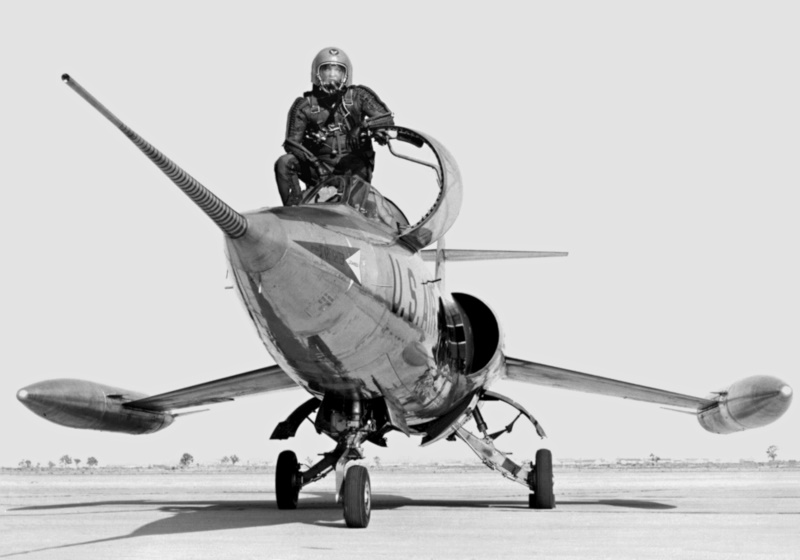
* The second XF-104 was already in the air by this time, having performed its first flight on 6 October 1954. It was fitted from the outset with the afterburning J65-W-7. This aircraft was primarily intended for armament tests. Although the original idea was that the machine would be fitted with twin 30-millimeter cannon, a decision was made to go with the new high-speed GE TE-171-E3 (later M61) "Vulcan" six-barreled Gatling 20-millimeter cannon. The aircraft was also fitted with the AN/ASG-14T-1 fire control system (FCS).
The cannon tests ran into snags: on 17 December 1954, Levier tried to fire a burst at high altitude and was rewarded with an explosion. The engine began running rough and Levier shut it down, gliding 80 kilometers (50 miles) to put the machine down safely. As it turned out, a 20-millimeter cartridge had exploded while being fired, blowing off the back of the cannon and sending it through the section of the aircraft behind it. In a sense, the XF-104 had shot itself down.
The aircraft was repaired and returned to flight test. However, on 14 April 1955 Lockheed test pilot Herman R. "Fish" Salmon was performing cannon tests, setting up vibrations so severe that they blew off the ejection seat door in the bottom of the cockpit. The cockpit depressurized and Salmon's pressure suit puffed up so much that he couldn't see what was going on. Had he understood the problem he could have gone to low altitude, equalizing the pressure and allowing him to get things under control, but he had no real idea of what had gone wrong and decided to eject, coming to earth safely. Of course, the second prototype cratered into the ground and was destroyed. An F-94C Starfire interceptor was modified to complete the armament tests.
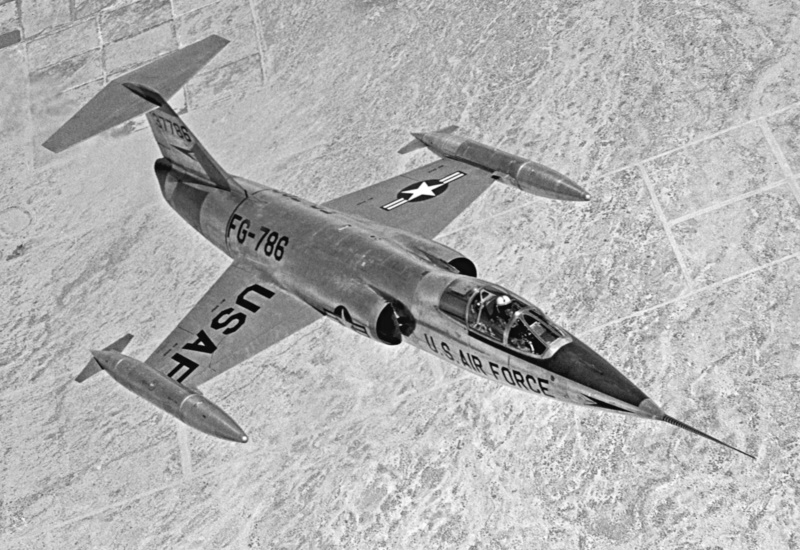
The first XF-104 would also be lost in a crash later. On 11 July 1957, Lockheed test pilot William M. "Bill" Park -- who would later fly the HAVE BLUE demonstrator that led to the F-117 Stealth Fighter -- was flying the XF-104 as a chase plane when flutter tore the tail off. Park ejected safely, and the aircraft fell to earth.
BACK_TO_TOP* The loss of the prototypes didn't slow the program down. The USAF had awarded Lockheed a contract for 17 "YF-104" pre-production evaluation machines on 30 March 1955. By the end of the year, GE was shipping YJ79-GE-3 evaluation engines to Lockheed, and the first YF-104A performed its initial flight on 17 February 1956. Herman Salmon was at the controls, obviously not overly fazed by his ejection from the number-two XF-104 just two days earlier. The YF-104 broke Mach 2 on 28 February.
The YF-104A was 1.68 meters (5 feet 6 inches) longer than the XF-104 to allow it to accommodate the J79 engine, with the stretch allowing it to carry more fuel as well. It also introduced a new inlet scheme, featuring a fixed half-cone in each inlet. The half-cones were called "shock cones" or more informally "flight falsies" -- a "falsie" being Yank slang for a padded brassiere -- and the scheme was a big secret at the outset. The nosewheel assembly was also changed to retract forward, to provide better clearance for the downward-firing ejection seat. Other minor changes involved a taller tailfin and a dorsal spine.
The YF-104s were intended to evaluate the J79 engine, the GE M61 Vulcan cannon, the AIM-9 (originally GAR-8) Sidewinder air-to-air missile (AAM), and wingtip fuel tanks with a capacity of 644 liters (170 US gallons) each, as well determine the Starfighter's flight envelope. The YJ79-GE-3 evaluation engines provided 65.9 kN (6,715 kgp / 14,800 lbf) afterburning thrust.
The USAF seemed more or less sold on the F-104, awarding Lockheed a contract on 2 March 1956 for an initial batch of production aircraft. The contract actually specified four different Starfighter variants:
The next month, the Starfighter was finally unveiled to the public, the program having been kept as secret as possible to that time. Initial photographs featured a YF-104 with the intakes covered by neat fairings to conceal the intake cones.
Late in 1956, Lockheed got a contract for a dedicated reconnaissance version of the Starfighter, designated the "RF-104A" and at least informally known as the "Stargazer". However, this contract was canceled within a few months, the Air Force deciding to focus on the McDonnell RF-101 Voodoo for the tactical reconnaissance mission. Reconnaissance Starfighters would fly, but not with the USAF.
* The F-104A entered formal USAF service in late February 1958. Its form followed that of the YF-104A, being a dartlike machine with trapezoidal wings, a high tee tail, and tricycle landing gear, though the airframe had been reinforced to handle higher gee stresses. It was powered by a J79-GE-3B turbojet engine, which had similar performance to the earlier -3 and -3A engines used on the YF-104As, but was more reliable. The early J79 variants were badly prone to engine failures; it appears that early F-104A production used the -3A variant, but it was quickly replaced when the -3B became available. The engine could be accessed by pulling off the rear fuselage after undoing four bolts. The Starfighter had been designed to be easy to maintain, and it was regarded as very maintainable by the standards of the time. There was a ram-air turbine (RAT) in a pop-out door on the lower right side of the fuselage, just behind the nose gear, to provide electrical and hydraulic power in case of systems failure.
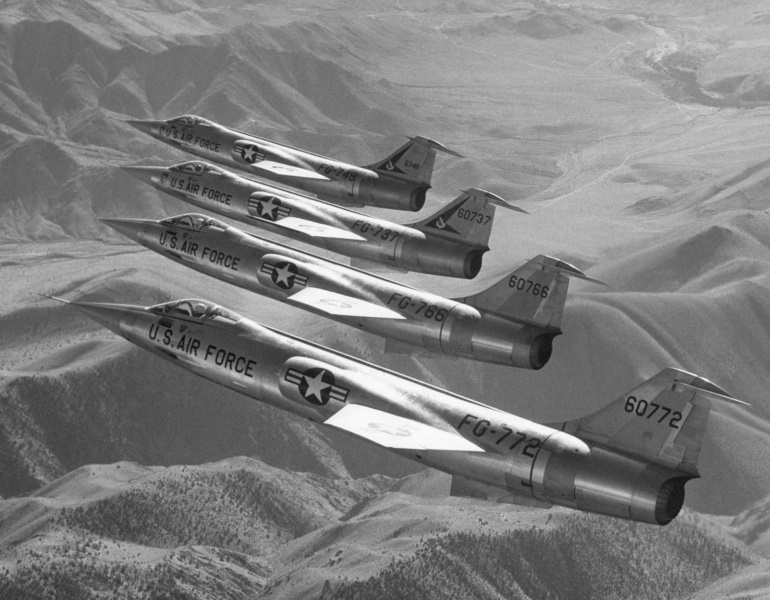
The wing had twin spars, a leading-edge sweep of 26 degrees, a trailing-edge sweep of 18.1 degrees, a ratio of wingroot length to thickness of 3.36%, and an anhedral droop of ten degrees. The edges were sharp enough to require that they be covered with felt strips during maintenance to keep from gashing the ground crews. Each wing had a full-span leading-edge flap, and a large trailing-edge flap inboard of the aileron. Engine bleed air was fed through a slot on the top of the wing just forward of each trailing-edge flap, with this "blown flaps" or "boundary layer control (BLC)" scheme further improving low-speed handling. The Starfighter is said to have been the first production aircraft to feature BLC. Despite the small wings and the sleek fuselage, the landing speed was comparable to that of existing fighters, though still on the "hot" side, and so a ribbon-style brake parachute was fitted, popping out from under the tail of the aircraft.
The high tee tail had a conventional rudder with hydraulic power boost, but an all-moving tailplane. The tee configuration was selected to provide a longer "lever arm", improving the effect of the elevators. It did tend to undermine roll stability, and so the last YF-104A evaluated a ventral fin that was then flowed into production. Some sources claim early production F-104As did not have the ventral fin, but these machines appear to be YF-104As that were brought up to operational spec.
A runway arresting hook was fitted offset to the right and behind the ventral fin, but many pictures of F-104As do not show the arresting hook, and it appears to have been a late addition in production. The introduction and retrofit of features implies that the configuration of the F-104A was something of a moving target; in fact, the precise configuration of early Starfighter variants is a confusing subject in general, with many small contradictions between sources.
The sole armament of the F-104A was the heat-seeking AIM-9B Sidewinder, with one carried on each wingtip. Wingtip tanks could be carried as well, but of course missile armament could not be carried if the wingtip tanks were fitted. Sources indicate that it could also carry the MB-1 Genie AAM, an unguided weapon with a small nuclear warhead, launched from a trapeze under the fuselage. Apparently this was never more than a trial fit, and if there are any images of a Starfighter with a Genie, they're hard to find.
Although the F-104A was to carry the GE Vulcan cannon -- firing out a blister on the left side of the fuselage below the cockpit and belt-fed from an ammunition drum with a capacity of 725 rounds -- GE was having big problems getting the Vulcan to work. As a result, it was dropped from the F-104A. GE would finally introduce the serviceable M61A1 Vulcan variant in 1959, and F-104As would be gradually refitted with the cannon.
The F-104A could be fitted with a single stores pylon under each wing for use with external tanks, with each underwing tank having a capacity of 739 liters (195 US gallons). These underwing pylons were not fitted for carriage of Sidewinder AAMs, and were apparently never used for carrying anything but external tanks. Some sources insist that the F-104A didn't have the underwing pylons, but this is contradicted by manufacturer's drawings.
Avionics included the AN/ASG-14T-1 FCS, a TACAN beacon-navigation system, and radio. There was also an infrared sight, manifested by a little window at the bottom of the windscreen, but sources are very vague about its details. It is an indication of how much more complicated aircraft are today when statistics for an F-104A in contemporary dollars give the price of the entire aircraft as a little over $1.7 million USD, with avionics amounting to only a bit over $3,400 USD of that. These days, that would hardly buy a high-end home high-definition TV system -- much less a state-of-the art fighter radar, navigation / communications system, and countermeasures suite.
153 F-104As were built, not counting the 17 YF-104As, with the last batch accepted by the USAF in December 1958. As mentioned, some of the YF-104As were brought up to production spec and put into service.
While the Starfighter was being brought into operational service, it was also breaking performance records. On 7 May 1958, USAF Major Howard C. "Scrappy" Johnson took the world altitude record, flying a YF-104A to meters (91,249 feet) over Edwards AFB. On 16 May, a YF-104A flown by USAF Captain Walter Irwin set a world speed record, traversing a 15 x 25 kilometer (9.3 x 15.5) mile circuit at Edwards at an average speed of 2,260.75 KPH (1,404.19 MPH). In December 1958, an F-104A flying out of the naval air station at Point Mugu, California, set a series of climb rate records.
BACK_TO_TOP* The initial flight of a two-seat F-104B was on 16 January 1957. The first aircraft was called the "YF-104B", but it was on the books simply as an F-104B. The F-104B was a fairly minimal change from the F-104A, with both variants having the same length. Fitting the twin cockpit required removing the Vulcan cannon; some sources claim the cannon could be refitted, but this seems to be an error. External stores capability and avionics were exactly the same as for the F-104A. Lockheed had offered the USAF a two-seater without combat capability, designated the "TF-104A", but the Air Force turned it down.
The nosewheel reverted to the backward-retracting configuration used on the YF-104A to deal with the modified crew arrangement, and the tailfin was extended back over the exhaust to increase its area by 25% to provide better yaw control, compensating for the aerodynamic interference of long tandem canopy. The rudder was larger, and so power actuation was added. The back seat was raised to give the instructor a good forward view. Each cockpit had its own canopy, hinging open to the right.
The F-104B went into formal USAF service in early 1958, in parallel with the F-104A. A total of 26 F-104Bs was built. Although apparently some consideration was given to using the F-104B as an advanced trainer for cadet pilots, in practice the type was used as a conversion trainer, with a few two-seaters supplied to F-104A squadrons to get fresh pilots up to speed on the idiosyncrasies of flying the Starfighter.
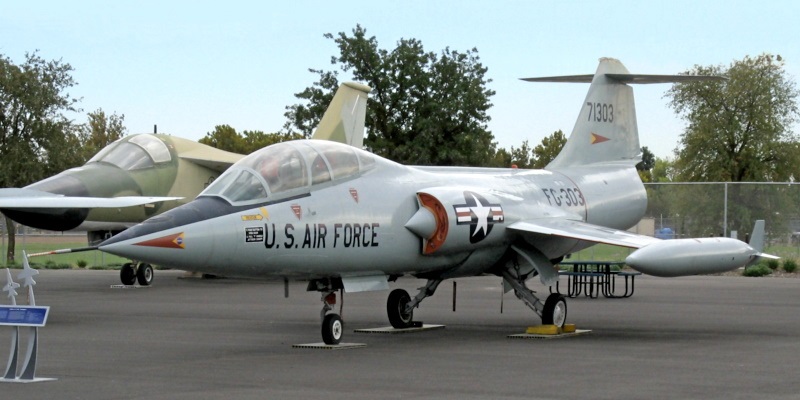
* The first single-seat F-104C fighter-bomber variant made its initial flight on 24 July 1958 and began to go into service late in that year, essentially taking up the slack as F-104A production tapered off. The F-104C was hard to tell from the F-104A, the most distinctive difference being that the F-104C could be fitted with a fixed inflight refueling probe to the right of the cockpit for probe-&-drogue refueling.
The F-104C also added a centerline pylon, essentially to carry a parachute-retarded nuclear store. Some sources claim the centerline pylon was "wet", capable of carrying an external fuel tank; that F-104As could be fitted with the centerline pylon; and the F-104C's underwing pylons were wired for Sidewinder carriage; but all these assertions seem to be incorrect. The F-104C's centerline pylon could be fitted with a "catamaran" double stores rack for two Sidewinders, but the rack caused too much drag and was rarely carried. The F-104C's primary weapon for the strike role was the B28 nuclear store. Depending on variant, the B28 could have yields of from 70 kilotons to 1.45 megatons.
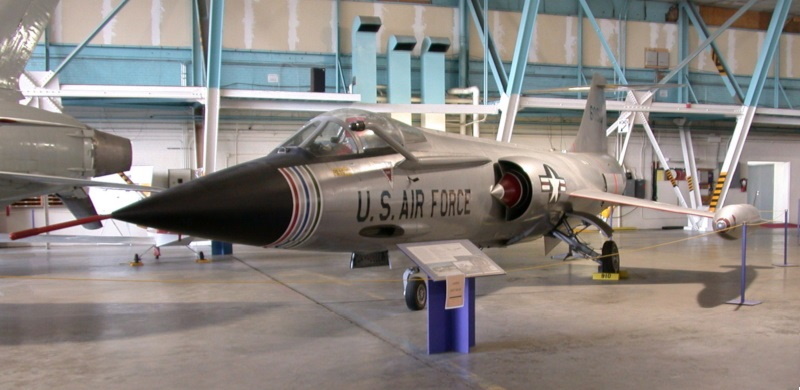
The F-104C featured the full-specification AN/ASG-14T-2 FCS and an improved J79-GE-7A engine, with 44.5 kN (4,535 kgp / 10,000 lbf) dry thrust and 70.3 kN (7,170 kgp / 15,800 lbf) afterburning thrust. The despised downward-firing ejection seat was replaced by a much more satisfactory Lockheed C-2 rocket-boosted upward-firing ejection seat.
___________________________________________________________________
LOCKHEED F-104C STARFIGHTER:
___________________________________________________________________
wingspan:
6.63 meters (21 feet 9 inches)
wing area:
18.22 sq_meters (196.1 sq_feet)
length:
16.66 meters (54 feet 8 inches)
height:
4.09 meters (13 feet 5 inches)
empty weight:
5,790 kilograms (12,760 pounds)
MTO weight:
12,635 kilograms (27,855 pounds)
max speed at altitude:
1,850 KPH (1,150 MPH / 1,000 KT)
service ceiling:
17,675 meters (58,000 feet)
range, no tanks:
1,370 kilometers (850 MI / 740 NMI)
___________________________________________________________________
A total of 77 F-104Cs was built, all delivered from late 1958 into late 1959. An F-104C set a new world altitude record on 14 December 1959, reaching 31,513 meters (103,389 feet) in 15 minutes 4.92 seconds. It was the first time an aircraft that took off under its own power had exceeded the 100,000-foot mark.
* The two-seat F-104D could be seen as an F-104B with much the same enhancements as the F-104C had over the F-104A, including the refueling probe, centerline pylon, J79-GE-7A engine, C-2 ejection seats, and enhanced avionics. The canopy was distinctively modified, however, by adding a fixed center section between the front and back seat cockpits, a feature associated with fit of the upward-firing ejection seats, possibly to provide a blast screen. It appears at least some F-104Bs were updated with the new canopy. Initial flight was on 31 October 1958, and 21 were built, in parallel with the F-104Cs.
BACK_TO_TOP* The Starfighter had a generally short-lived and undistinguished career in USAF service, with the Air Force buying less than half the total number of machines initially planned. In fact, at the outset the Starfighter's most noticeable characteristic was its high accident rate, with 49 lost up to 1961. Partly the problem was the type's unprecedented high performance; partly the problem was its immaturity, J79 engine failures being a particular trouble; and partly the problem was that even when everything was working right, it was a demanding aircraft and not friendly to inexperienced pilots.
The downward-firing ejection seat was a very unpopular feature, since it meant that surviving a failure at low altitude was very unlikely. Pilots were supposed to try to roll the aircraft over for a low-altitude escape, but that was not necessarily easy to do. Well-known test pilot and ace Iven C. Kincheloe was killed in an F-104A at Edwards AFB on 26 July 1958; he tried to roll over, but ended up punching out sideways.
The F-104A's combat utility was marginal at best. It lacked the combat avionics of a proper interceptor, and in hindsight its armament was inadequate. Many sources complain about its limited range, but the type's defenders insist that it was comparable to other fast combat jets of the time, none of which had very good range if afterburner were engaged for long periods. The F-104C was more satisfactory, basically the machine that Kelly Johnson had been planning to build.
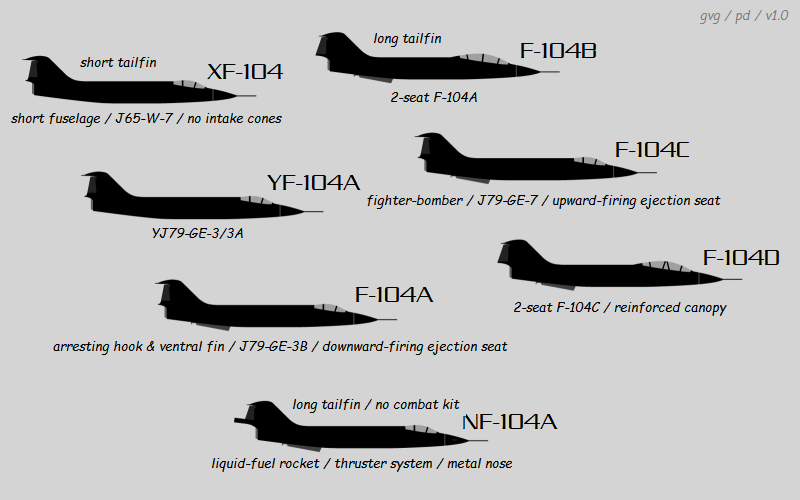
In fact, all the F-104As and F-104Bs had been relegated to US Air National Guard (USANG) service by late 1960, though they would be returned during national emergencies to USAF ADC service on occasion through the decade, being finally phased out in 1969. Some would end up in the hands of foreign air arms, and 24 of them, including a few of the YF-104As, would be converted beginning in 1960 to "QF-104A" high speed target drones. The QF-104As, painted in overall dayglo orange, were flow out of Eglin AFB in Florida and remained in service for some time. Some authors have commented that flying a demanding aircraft like the Starfighter by remote control was likely a very challenging task. The more satisfactory F-104C and F-104D would remain in first-line service longer than the F-104A, as discussed below.
The main factor in the short service life of the F-104/B in ADC service may have had something to do with its defects and limitations, but it is also unclear in hindsight why the ADC acquired it in the first place. The ADC's primary weapon was the Convair F-106 Delta Dart, a superlative aircraft that was optimized for the intercept role. The primary rationale for buying the Starfighter seems to have been to acquire experience with flying and operating the new Mach 2 aircraft coming out the end of the pipe; in other words, it was something of a neat toy to play with.
Almost as confusingly, TAC never really used the F104C/D in the fighter-bomber role, dedicating it to air superiority. Why the nuclear strike capability was added is a bit of a puzzle, though it might have been because of TAC culture, or the US Congress: TAC flew fighter-bombers and so anything they got had to be a fighter-bomber, at least on paper.
There doesn't seem to be much record of Starfighter pilots expressing any great fear or dislike of the type, as is generally the case for unpleasant aircraft. They learned the idiosyncrasies of the F-104, and the bugs were worked out; an engine upgrade program conducted by GE in the early 1960s did much to cut down the disastrous engine problems. In fact, it appears that pilots really liked flying the F-104, appreciating its blazing speed and zoom climb. In the attack role, although the Starfighter lacked the ruggedness needed to survive enemy air defenses, its tiny wing gave it a fast smooth ride at low level. It did have a notoriously wide turning radius; but some sources say that, due to the tee tail, it could turn tightly in the vertical plane, and an F-104 pilot who understood this could get on the tail of a pursuer with surprising ease.
Although marketing copy and the press liked to call the F-104 the "Manned Missile", aircrews actually called it the "Zipper" or "Zip-Four". Starfighter pilots did everything they could to master the dogfighting role and believed, with some good reason, that they could take on anyone and anything that an enemy could throw at them, and win.
* A dozen F-104As were airlifted by Douglas C-124 Globemaster cargolifters to Taiwan in October 1958 during the Quemoy-Matsu crisis in that year, but saw no action.
The Starfighter did see combat with the USAF in Vietnam. When the air war ramped up in early 1965, the US found North Vietnamese air defenses to be much more formidable than had been expected, with North Vietnamese MiGs presenting a threat to American aircraft. 28 F-104Cs were dispatched to the war theater in April 1965, where they flew from the big air base at Da Nang in South Vietnam. They were used to perform combat air patrols (CAPs) to protect EC-121 Warning Star aircraft, known to pilots as "College Eye" and later "Disco", which were radar warning system adaptations of the Lockheed Constellation four-piston airliner. A Boeing KC-135 tanker stood by to keep the F-104s in the air. The Starfighters arrived in their normal stateside natural metal finish, but were quickly given a camouflage paint job, with white on the underside and tan / dark green / olive drab disruptive patterning on top.
The Warning Stars could tip off strike packages to the whereabouts of enemy fighters, and the North Vietnamese had a strong motive to shoot them down. However, the North Vietnamese showed no inclination to want to take on the F-104s, and the Starfighters saw no action in this role. They were also put into use in the ground-attack role, mostly performing strikes "in-country" on targets in South Vietnam. It proved effective as a strike aircraft at first, and its speed and small frontal area made it a difficult target for enemy anti-aircraft gunners.
Losses occurred. An F-104C was shot down by ground fire on 22 July 1965, the pilot, Captain Roy Blakely, being killed. On 20 September 1965, Captain Phil Smith was flying a CAP over the Gulf of Tonkin at night and in murky weather. He got lost, strayed over the Chinese island of Hainan, was "bounced" by Chinese MiG-19s when he dropped out of the cloud cover to get his bearings, and was shot down. He was interned in a Chinese prison camp until 1973. Worse, two F-104Cs that went looking for him collided in the lousy weather and were lost -- though both pilots ejected safely, and were recovered.
The F-104Cs were back stateside by Christmas 1965, having in principle been replaced by the McDonnell F-4 Phantom. However, increased activity of speedy North Vietnamese MiG-21 fighters led to a reconsideration of the withdrawal of the Starfighter, and eight were sent to the air base at Udorn, Thailand, in late June 1966. The Starfighters were used to provide top cover for F-105F Wild Weasel defense suppression aircraft, looking out for MiGs while the Weasels took on air-defense sites -- but two F-104Cs were shot down by surface-to-air missiles (SAMs) on 1 August 1966, both pilots being killed.
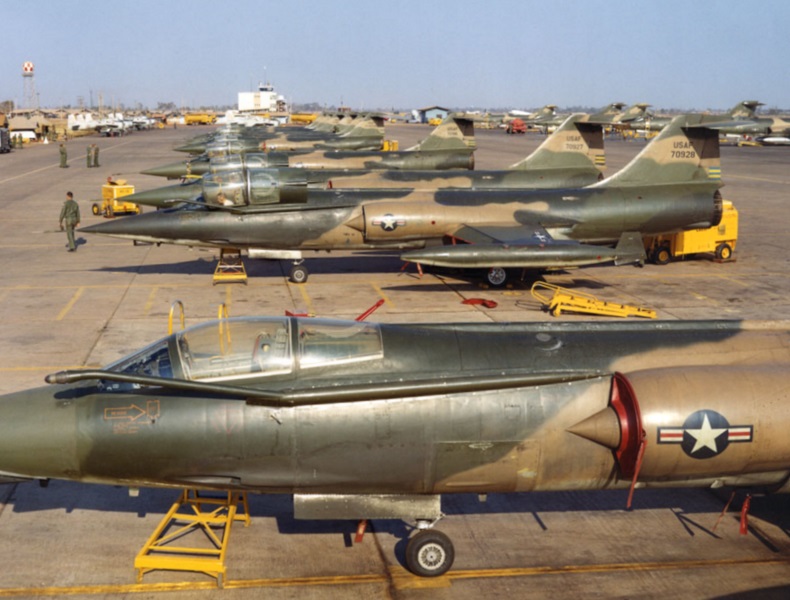
The conclusion was that the whole idea of providing escorts for the Weasels was a bad one, since the F-105s moved fast at low level; MiGs would be hard-pressed to find them, much less catch them, and so the loss of the two pilots was senseless. The Starfighters went back to the close-support role again, but enemy air defenses were steadily getting nastier, and the losses mounted. Major Norman Schmidt, an experienced Korean War veteran, was shot down over Laos on 1 September 1966. He was taken prisoner, to die in a POW camp. On 2 October, Captain Norman Lockard was shot down by a SAM, fortunately being rescued. Captain Charles Toffert was lost over Laos on 20 October and listed as missing in action, presumed dead; that was the end of Starfighter close-support missions over Southeast Asia.
The Starfighters went back to Warning Star protection missions for a time, being fitted with a radar warning receiver (RWR) system with a prominent antenna fairing under the nose to improve survivability. However, all the Starfighters were finally withdrawn back to the States in July 1967. Keeping what amounted to a single-role type of very limited numbers in the field was becoming a logistical headache.
Although some sources indicate that the Starfighter was withdrawn from the combat theater because it was regarded as unsatisfactory, as the discussion above suggests, it wasn't quite that simple. An official document balanced the experience of the F-104 in the Vietnam War as follows:
BEGIN QUOTE:
If the Starfighter is judged against other US aircraft for its ability to sustain battle damage, to deliver heavy bomb loads or to conduct operations in bad weather, then the F-104 rates as an "also-ran". If, however, the F-104C is judged for its ability to deter MiGs, to ensure the safety of aircraft entrusted to its escort or to out-perform any aircraft in existence at the time, the "Zip-4" is unrivaled!
END QUOTE
The F-104C and F-104D were phased out of first-line service in 1967, to serve with the Puerto Rican ANG into the mid-1970s. Some were passed on to foreign air forces after their retirement. Foreign and other non-USAF use of the F-104 is discussed in the next chapter.
BACK_TO_TOP* In the early 1960s, the USAF Test Pilot School at Edwards AFB ordered three modified ex-USAF F-104As for astronaut qualification. These aircraft were stripped of combat gear, including wingtip tank capability, and were fitted with:
These aircraft were delivered by Lockheed in late 1963 and were given the designation of "NF-104A". An NF-104A set a world altitude record on 15 November 1963, reaching 36,237 meters (118,860 feet), a record that was soon broken on 6 December 1963, with the NF-104A reaching meters (120,800 feet). One was then lost on 10 December 1963 during an attempt to break that record, the pilot, school commandant Colonel Chuck Yeager, ejecting successfully, though he was badly burned when his pressure suit caught fire.
This story remains murky, with Yeager claiming he was caught in a vicious three-axis spin, which was how the incident was reported in Yeager's autobiography, Tom Wolfe's best-seller THE RIGHT STUFF, and the hit movie made of Wolfe's book. Yeager's critics reply that:
Which version is the truth is hard to say. Yeager was, to put it tactfully, outspoken and not short on self-esteem. There were those who crossed his path, didn't like his style, and were not inclined to say kind things about him.
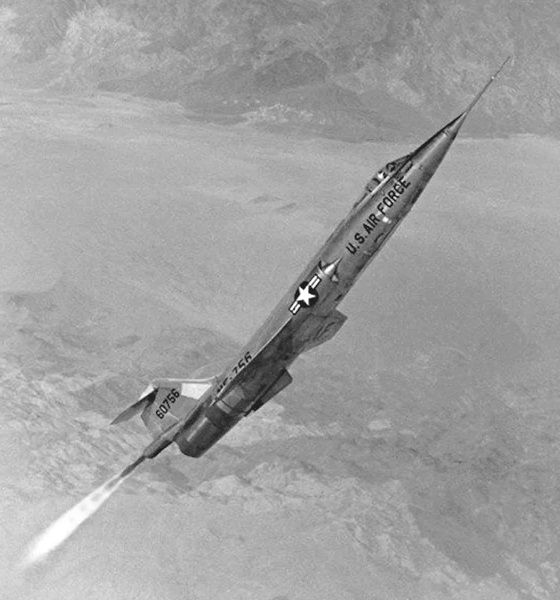
Whatever the true facts of the case, the other two NF-104As remained in service through the 1960s. One suffered an inflight explosion in June 1971, but the pilot brought it down safely. It was going to be retired soon anyway, so it wasn't rebuilt. The last NF-104A was retired in December 1971 and at last notice was a "gate guard" at the school. The test pilot school also operated a number of F-104As and F-104Bs.
BACK_TO_TOP